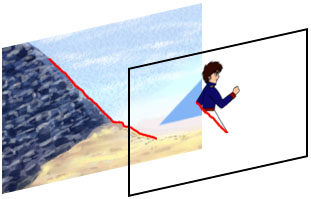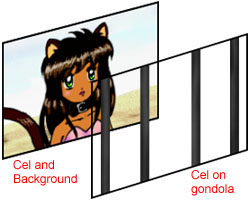

 |
|||
 |
Japanese Animation Camera Work (continued)
 Red line indicates kumisen. Actual line would be invisible.
This can also be used for cels. Let's say you have 2 characters on different levels, one slightly in front of the other. The top character reaches back behind the character in the rear. This could be done by having a separate arm cel to go on the bottom but separate cels cost more so they often do it by using a reg line, cutting off the parts of the character's arm that would be behind the character in back.  This is similar to a pan but the camera "moves" along with the action.
There are often multiple foreground and background levels in the cut which move at different rates. A follow is normally done by sliding books and the BG past the camera. The movement of each of the elements is specified on the time sheet, usually how many millimeters it moves to the right or left per frame or per second.
 The background and other elements are sometimes too short so once they are moved to the end the camera operator moves them back to the beginning and moves them through the cut again. (Remember in THE FLINTSTONES when Fred runs through the house and passes the same table and lamp a few dozen times?)
 Sometimes this movement is nonlinear. A tsuke pan has a guide, called a Memory, for the camera operator to follow.
 This refers to a camera setup with a number of different racks between the camera and the stand. This allows depth of field as the elements would be in different degrees of focus depending on their proximity to the lens and where the camera was focused and also allowed more interesting things to go on in various parts of the cut.  The uppermost rack on the camera, just below the lens, is known as the gondola. It is most commonly used for cuts where there is something very close to where the viewer would be and other elements in the distance. Only one of these can be focused on at a given time so this gives great depth to a cut.

The focus can be changed from one level to another. This is knows as a focus pull or rack focus. Focus in/out usually refers to the entire cut or a superimposed element. |